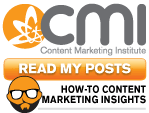 Content is powerful, particularly with respect to the sales cycle. Unleashing the power of content to engage your prospects was the subject of a fascinating presentation at the MarketingProfs B2B Forum 2010 that took place in Boston. It, too, was powerful!
Content is powerful, particularly with respect to the sales cycle. Unleashing the power of content to engage your prospects was the subject of a fascinating presentation at the MarketingProfs B2B Forum 2010 that took place in Boston. It, too, was powerful!Here follow my notes from this session on content marketing which broke into two parts:
..The theory behind content marketing presented by Stephanie Tilton and Michele Linn.
..Two case studies: from Pam O'Neal, Breaking Point Systems, and Amy Black, Kadient, which reinforced the points that Michele and Stephanie made.
Part 1: Content Marketing Strategy to Unleash the Power of Content to Engage Your Prospects
Content marketing makes intuitive sense to me. What better way is there to answer customer questions than through content? [See Digital Visibility: The Reason Behind Content Marketing for more information.] Buyers want information; they seek out relevant content to help them make sense of the options available. As Linn and Tilton explained, business people need to deliver high quality relevant content that answers buyer questions based on where they are in the sales cycle.
What is most important is accepting that the sales process has nothing to do with your products and services and everything to do with where your customer is in the sales process and what related issues s/he faces. To help craft an optimal content marketing strategy, consider the following 8 steps:
1. Listen
Pay close attention to what customers are saying. Use Google alerts, search Twitter/tweetbeep, don't forget Google blog search and consider following the top 10 sources [i.e., blogs] in your industry.2. Develop buyer personas
Next, you want to understand your audience. That's where developing buyer personas can be valuable to help bring customers to life. Your goal in developing buyer personas is to know as much about them as possible.3. Map content to the buying cycle
Once you have a sense for who your customers are based on developing buyer personas, spend time understanding your customers' buying cycle and then map your content to that buying process. Remember, customers and prospects may have very different needs.4. Think like a publisher
Next, get organized and think like a publisher. Fully understand content preferences. Do your readers/visitors prefer video content? Do they prefer another source? Understand how that affects your business and your content.Develop an editorial calendar that maps out to potential customers' buying cycle. Don't forget to include a call to action.
5. Commit to remarkable content
Be aware of what is relevant to your buyer, understand at which stage of the buying cycle s/he is and create the best possible content to answer questions, address objections and generally help your customer feel comfortable with the purchase and the process.6. Extract maximum value from every asset
Repurpose your remarkable content as much as possible - from a white paper to a series of blog posts, to a video to a podcast. Think about the different ways to communicate your message and the different ways to understand something. Don't just regurgitate; make sure you add value to the content in its new form.7. Make your content easy to find, access, and share
Be sure to choose the best possible platform for the content based on your customer's needs and preferences. Don't ask for any more information than necessary to facilitate the sharing of content. Test different approaches.8. Measure
Be sure to measure the impact of your content marketing.Part 2: Case Studies that Unleash the Power of Content to Engage Your Prospects
Pam O'Neal from Breaking Point Systems, a cyber-security firm, shared a case study titled " How BreakingPoint Leveraged Technical Content to Increase New Customer Acquisition by 240%". Pam's first point: be interesting; be what people are interested in. That will help you be found.
To be interesting: ask customers, understand buyers, monitor and engage influencers, analyze trends, test content and copy, measure results. Easy, right?
A few pearls of wisdom:
- Marketers need to become peers to their audience. Too often, data sheets lie.
- Develop personas to better understand buyers.
- Attack marketers! Become the company that doesn't overstate anything!
[Pam brought up the value of coordinating company descriptions and key words in LinkedIn used in the profiles of company employees.]
Breaking Point develop a 'content engine': starting with MarketWire, then Pitchengine 3 weeks later, don't forget to use Twitter, RSS, email, include top content in newsletters, upload diagrams to Flickr and presentations to SlideShare [e.g., presentation guides, sales #s], and update status on LinkedIn.
Integrate content with drip marketing approach so you can drive people to specfic content.
Results:
Breaking Point is doing 100 events because of new business and is starting to see better quality leads coming in from content created for the web.
Amy Black formerly with Kadient addressed "Building a Content Library that Maps to the Sales Cycle" in her case study.
Her objective had to do with building a content library that maps to the Kadient sales cycle and represented a major shift in offering as well as to whom and how. She had in mind creating a sales playbook and the best way to do that was by developing a content library.
She urged the audience to think about the key objective for content and how else to make value out of it. She had in mind a How To guide, in a fresh format that was somewhat provocative in that it promoted new ways of thinking [e.g., Confessions of a Sales VP]. Next, she created a video series based on "There's a playbook for that." Benefits led to lead generation, sales and also reputation building.
Important, too, to nurture and harness customer voices thereby highlighting 3rd party validation.
The content library converts leads to opportunity; it connects prospects with internal expertise and then creates a better opportunity to close a sale by demonstrating how Kadient is different and addressing customer questions and objectives in a credible manner.
Her parting thoughts:
- Remember who you are “talking” to
- Keep your key objective front and center
- Break through the clutter – stand out!
- Entertainment
- Provocative POVs
- Video – short, sweet and interesting
- Create content you can repurpose
- Listen to your sales team
- Pay attention to what is & isn’t working
I've also embedded the slide presentation so you can dive into more detail.
Stephanie and Michele shared some additional content marketing advice:
1. How well do you know your ideal reader and his/her concerns?
2. Does your content answer the question "what's in it for me?" from the perspective of your target audience?
3. Have you created content for each role and stage in the buying cycle?
4. Have you developed an editorial calendar to make sure you consistently publish content?
5. Do your titles and design draw the reader in?
6. Does your content have a call to action?
7. Can prospects easily find, access and share your content?
8. Do you need to require registration? If so, which information do you really need to collect?
9. Does your content engage while educating?
10. Are you extracting the most value possible from your content?
11. Can you measure the effectiveness of your conent?
I wish you the best as you unleash the power of your content marketing! And when you do, I hope you'll share your learnings with us here.
------------------------
Image credit:
MarketingProfs B2B Forum - Boston originally loaded by Bob_Collins.








No comments:
Post a Comment
Reminder: Please, no self-promotional or SPAM comments. Don't bother if you're simply trying to build inauthentic link juice. Finally, don't be anonymous: it's too hard to have a conversation. Thanks, CB